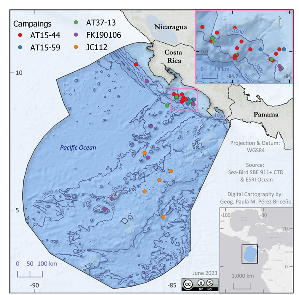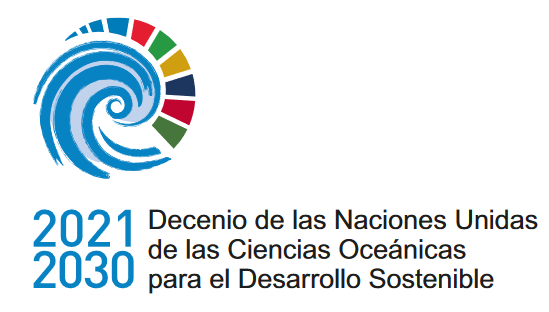Caracterización de la Zona Mínima de Oxígeno en el Pacífico Tropical Oriental costarricense utilizando datos in situ de campañas de campo
DOI:
https://doi.org/10.47193/mafis.37X2024010111Palabras clave:
Anoxia, colaboración internacional, América Central, filtraciones de metano, márgenes continentales, perfiles de CTDResumen
Para la conservación y la pesca sostenible, es importante caracterizar las Zonas de Mínimo de Oxígeno o ZMO en y alrededor de las filtraciones de metano del Pacífico Tropical Oriental, Costa Rica, mediante el análisis de perfiles de temperatura, salinidad, densidad y oxígeno. Los datos utilizados en este trabajo fueron recolectados durante diferentes campañas de investigación oceanográfica en el margen continental del Pacífico de Costa Rica, entre 2009 y 2019, utilizando un CTD, como perfilador de parámetros físicos de la columna de agua. En general, se observó que el oxígeno disuelto disminuye gradualmente con la profundidad hasta la termoclina, luego su concentración disminuye más rápidamente y permanece baja, indicando la presencia de la OMZ y tiende a aumentar ligeramente a mayores profundidades. La extensión vertical media de la OMZ cerca y alrededor de las filtraciones fue de 763 m y la profundidad media del valor mínimo de oxígeno disuelto fue de 393 m. Se calcularon las diferencias espaciales de las mediciones realizadas en las estaciones cercanas a las filtraciones de metano con respecto a las mediciones en la estación ubicada sobre ellas. En términos generales, se observó una mayor variabilidad de las anomalías de oxígeno dentro de la capa de mezcla, mientras que bajo la termoclina sus valores se mantienen estables y alrededor de cero.
Descargas
Métricas
Citas
Alfaro E, Lizano O. 2001. Algunas relaciones entre las zonas de surgencia del Pacífico Centroamericano y los Océanos Pacífico y Atlántico Tropical. Rev Biol Trop. 49 (2): 185-193. https://www.kerwa.ucr.ac.cr/handle/10669/76681.
Amador JA, Rivera ER, Durán-Quesada AM, Mora G, Sáenz F, Calderón B, Mora N. 2016a. The easternmost tropical Pacific. Part I: a climate review. Rev Biol Trop. 64 (1): 1-22. DOI: https://doi.org/10.15517/rbt.v64i1.23407
Amador JA, Durán-Quesada AM, Rivera ER, Mora G, Sáenz F, Calderón B, Mora N. 2016b. The easternmost tropical Pacific. Part II: seasonal and intraseasonal modes of atmospheric variability. Rev Biol Trop. 64 (1): 23-57. DOI: https://doi.org/10.15517/rbt.v64i1.23409
Breitburg D, Levin LA, Oschlies A, Grégoire M, Chavez FP, Conley DJ, Garçon V, Gilbert D, Gutiérrez D, Isensee K, et al. 2018. Declining oxygen in the global ocean and coastal waters. Science. 359 (6371): eaam7240. DOI: http://doi.org/10.1126/science.aam7240
Brenes CL, Coen JE. 1985. Correlación T-S de las masas de agua en la región del Domo Térmico de Costa Rica. Uniciencia. 2 (1): 41-50. https://www.revistas.una.ac.cr/index.php/uniciencia/article/view/5350.
Brenes CL, Ballestero D, Benavides R, Salazar, JP, Murillo, G. 2016. Variations in the geostrophic circulation pattern and thermohaline structure in the Southeast Central American Pacific. Rev Biol Trop. 64 (2): 121-134. DOI: https://doi.org/10.15517/rbt.v64i1.23421
Cabré A, Marinov I, Bernardello R, Bianchi D. 2015. Oxygen minimum zones in the tropical Pacific across CMIP5 models: mean state differences and climate change trends. Biogeosciences. 12 (18): 5429-5454. DOI: https://doi.org/10.5194/bg-12-5429-2015
Czeschel R, Stramma L, Johnson, G C. 2012. Oxygen decreases and variability in the eastern equatorial Pacific. J Geophys Res C Oceans. 117: C11019. DOI: https://doi.org/10.1029/2012JC008043
Dale AW, Sommer S, Lomnitz U, Montes I, Treude T, Liebetrau V, Gier J, Hensen C, Dengler M, Stolpovsky K, et al. 2015. Organic carbon production, mineralisation and preservation on the Peruvian margin. Biogeosciences. 12 (5): 1537-1559. DOI: https://doi.org/10.5194/bg-12-1537-2015
Deutsch C, Brix H, Ito T, Frenzel H, Thompson, L. 2011. Climate-forced variability of ocean hypoxia. Science. 333 (6040): 336-339. DOI: http://doi.org/10.1126/science.1202422
DeVries T, Deutsch C, Rafter PA, Primeau F. 2013. Marine denitrification rates determined from a global 3-D inverse model. Biogeosciences. 10: 2481-2496. DOI: http://doi.org/10.5194/bg-10-2481-2013
Durán-Quesada AM, Sorí R, Ordoñez P, Gimeno L. 2020. Climate perspectives in the intra-Americas Seas. Atmosphere-Basel. 11 (9): 959. DOI: https://doi.org/10.3390/atmos11090959
Duteil O, Oschlies A, Böning, CW. 2018. Pacific Decadal Oscillation and recent oxygen decline in the eastern tropical Pacific Ocean. Biogeosciences. 15 (23): 7111-7126. DOI: https://doi.org/10.5194/bg-15-7111-2018
Enfield DB. 1987. The intraseasonal oscillation in eastern Pacific Sea levels: How is it forced? J Phys Oceanogr. 17: 1860-1876. DOI: https://doi.org/10.1175/1520-0485(1987)017<1860:TIOIEP>2.0.CO;2
Escoto-Murillo A, Alfaro EJ. 2021. Análisis de eventos fríos y cálidos por medio de datos de buceo: un enfoque de ciencia ciudadana en el Golfo de Papagayo, Costa Rica. Rev Biol Trop. 69 (2): 94-104. DOI: https://doi.org/10.15517/rbt.v69iSuppl.2.48309
Espinoza-Morriberón D, Echevin V, Colas F, Tam J, Gutierrez D, Graco M, Ledesma J, Quispe-Ccalluari C. 2019. Oxygen variability during ENSO in the tropical South Eastern Pacific. Front Mar Sci. 5: 526. DOI: https://doi.org/10.3389/fmars.2018.00526
Fee EA. 2012. Extent of the oxygen minimum zone in the Eastern Tropical North Pacific [thesis]. Proceedings from the University of Washington. School of Oceanography, Academic Year 2011-2012. 8 p. http://hdl.handle.net/1773/20061.
Fiedler PC, Mendelssohn R, Palacios DM, Bograd SJ. 2013. Pycnocline variations in the eastern tropical and North Pacific, 1958-2008. J Climate. 26 (2): 583-599. DOI: https://doi.org/10.1175/JCLI-D-11-00728.1
Fiedler PC, Talley LD. 2006. Hydrography of the eastern tropical Pacific: a review. Prog Oceanog. 69 (2-4): 143-180. DOI: https://doi.org/10.1016/j.pocean.2006.03.008
Fu W, Bardin A, Primeau F. 2018. Tracing ventilation source of tropical Pacific oxygen minimum zones with an adjoint global ocean transport model. Deep-Sea Res Pt I. 139: 95-103. DOI: https://doi.org/10.1016/j.dsr.2018.07.017
Fuenzalida R, Schneider W, Garcés-Vargas J, Bravo L, Lange C. 2009. Vertical and horizontal extension of the oxygen minimum zone in the eastern South Pacific Ocean. Deep-Sea Res Pt II. 56 (16): 992-1003. DOI: https://doi.org/10.1016/j.dsr2.2008.11.001
García-Franco JL, Chadwick R, Gray LJ, Osprey S, Adams DK. 2023. Revisiting mechanisms of the Mesoamerican Midsummer drought. Clim Dyn. 60: 549-569. DOI: https://doi.org/10.1007/s00382-022-06338-6
Glud RN, Grossart HP, Larsen M, Tang KW, Arendt KE, Rysgaard S, Thamdrup B, Nielsen TG. 2015. Copepod carcasses as microbial hot spots for pelagic denitrification. Limnol Oceanog. 60 (6): 2026-2036. DOI: https://doi.org/10.1002/lno.10149
Gooday AJ, Bett BJ, Escobar E, Ingole B, Levin LA, Neira C, Raman AV, Sellanes, J. 2010. Habitat heterogeneity and its influence on benthic biodiversity in oxygen minimum zones. Mar Ecol. 31 (1): 125-147. DOI: http://doi.org/10.1111/j.1439-0485.2009.00348.x
Gruber N, Lachkar Z, Frenzel H, Marchesiello P, Münnich M, McWilliams JC, Nagai T, Plattner, GK. 2011. Eddy-induced reduction of biological production in eastern boundary upwelling systems. Nat Geosci. 4 (11): 787-792. DOI: https://doi.org/10.1038/ngeo1273
Helly JJ, Levin LA. 2004. Global distribution of naturally occurring marine hypoxia on continental margins. Deep-Sea Res Pt I. 51 (9): 1159-1168. DOI: https://doi.org/10.1016/j.dsr.2004.03.009
Ito T, Deutsch C. 2013. Variability of the oxygen minimum zone in the tropical North Pacific during the late twentieth century. Global Biogeochem Cycles. 27 (4): 1119-1128. DOI: https://doi.org/10.1002/2013GB004567
Ito T, Long MC, Deutsch C, Minobe S, Sun D. 2019. Mechanisms of low-frequency Oxygen variability in the North Pacific. Global Biogeochem Cycles. 33 (2): 110-124. DOI: https://doi.org/10.1029/2018GB005987
Karstensen J, Stramma L, Visbeck M. 2008. Oxygen minimum zones in the eastern tropical Atlantic and Pacific oceans. Prog Oceanog. 77 (4): 331-350. DOI: https://doi.org/10.1016/j.pocean.2007.05.009
Kirchman DL. 2021. Dead Zones: The loss of oxygen from rivers, lakes, seas, and the ocean. New York: Oxford University Press. 217 p.
Levin LA. 2002. Deep-ocean life where oxygen is scarce. Am Sci. 90 (5): 436-444. DOI: https://doi.org/10.1511/2002.33.436
Levin LA. 2003. Oxygen minimum zone benthos: adaptation and community response to hypoxia. In: GIBSON RN, ATKINSON RJA, editors. Oceanography and marine biology, an annual review. 41. London: CRC Press. p. 1-45.
Levin LA, Orphan VJ, Rouse GW, Rathburn AE, Ussler W, Cook GS, Goffredi SK, Perez EM, Waren A, Grupe BM, Chadwick G, Strickrott B. 2012. A hydrothermal seep on the Costa Rica margin: middle ground in a continuum of reducing ecosystems. Proc R Soc B. 279: 2580-2588. DOI: http://doi.org/10.1098/rspb.2012.0205
Lizano OG. 2016. Distribución espacio-temporal de la temperatura, salinidad y oxígeno disuelto alrededor del Domo Térmico de Costa Rica. Rev Biol Trop. 64 (1): 135-152. DOI: https://doi.org/10.15517/rbt.v64i1.23422
Loescher CR, Bange HW, Schmitz RA, Callbeck CM, Engel A, Hauss H, Kanzow T, Kiko R, Lavik G, Loginova A, et al. 2016. Water column biogeochemistry of oxygen minimum zones in the eastern tropical North Atlantic and eastern tropical South Pacific oceans. Biogeosciences. 13 (12): 3585-3606. DOI: https://doi.org/10.5194/bg-13-3585-2016
Matear RJ, Hirst AC. 2003. Long-term changes in dissolved oxygen concentrations in the ocean caused by protracted global warming. Global Biogeochem Cycles. 17 (4): 1125. DOI: https://doi.org/10.1029/2002GB001997
Mora-Escalante RE, Lizano OG, Alfaro EJ, Rodríguez A. 2020. Distribución de temperatura y salinidad en campañas oceanográficas recientes en el Pacífico Tropical Oriental de Costa Rica. Rev Biol Trop. 68 (1): 177-197. DOI: https://doi.org/10.15517/rbt.v68iS1.41180
Neira C, Ingels J, Mendoza G, Hernandez-Lopez E, Levin LA. 2018. Distribution of meiofauna in bathyal sediments influenced by the Oxygen Minimum Zone off Costa Rica. Front Mar Sci. 5: 448. DOI: http://doi.org/10.3389/fmars.2018.00448
Oschlies A, Schulz KG, Riebesell U, Schmittner A. 2008. Simulated 21st century’s increase in oceanic suboxia by CO2-enhanced biotic carbon export. Global Biogeochem Cycles. 22 (4): GB4008. DOI: https://doi.org/10.1029/2007GB003147
Paulmier A, Ruiz-Pino D. 2009. Oxygen minimum zones (OMZs) in the modern ocean. Prog Oceanog. 80 (3-4): 113-128. DOI: http://doi.org/10.1016/j.pocean.2008.08.001
Rixen T, Cowie G, Gaye B, Goes J, do Rosário Gomes H, Hood RR, Lachkar Z, Schmidt H, Segschneider J, Singh A. 2020. Reviews and syntheses: present, past, and future of the oxygen minimum zone in the northern Indian Ocean. Biogeosciences. 17 (23): 6051-6080. DOI: https://doi.org/10.5194/bg-17-6051-2020
Rodríguez A, Alfaro EJ, Cortés J. 2021. Spatial and temporal dynamics of the hydrology at Salinas Bay, Costa Rica, Eastern Tropical Pacific. Rev Biol Trop. 69 (2): 105-126. DOI: https://doi.org/10.15517/rbt.v69iSuppl.2.48314
Ross-Salazar E, Jiménez-Ramón JA, Castro-Campos M, Blanco-Bolaños M. 2019. Atlas Domo Térmico de Costa Rica. San José: Fundación MarViva. 108 p. https://marviva.net/atlas-del-domo-termico-de-costa-rica/.
Sarma VVSS, Bhaskar TU, Kumar JP, Chakraborty K. 2020. Potential mechanisms responsible for occurrence of core oxygen minimum zone in the north-eastern Arabian Sea. Deep-Sea Res Pt I. 165: 103393. DOI: https://doi.org/10.1016/j.dsr.2020.103393
Sea-Bird Electronics. 2013. SBE 43 Dissolved oxygen sensor: application note no. 64. https://www.seabird.com.
Sea-Bird Electronics. 2016. Seasoft V2 SBE Data processing: software manual. https://www.seabird.com.
Stief P, Lundgaard ASB, Morales-Ramírez Á, Thamdrup B, Glud RN. 2017. Fixed-nitrogen loss associated with sinking zooplankton carcasses in a coastal oxygen minimum zone (Golfo Dulce, Costa Rica). Front Mar Sci. 4: 152. DOI: https://doi.org/10.3389/fmars.2017.00152
Stramma L, Johnson GC, Firing E, Schmidtko S. 2010. Eastern Pacific oxygen minimum zones: supply paths and multidecadal changes. J Geophys Res-Oceans. 115: C09011. DOI: https://doi.org/10.1029/2009JC005976
Stramma L, Johnson GC, Sprintall J, Mohrholz V. 2008. Expanding oxygen-minimum zones in the tropical oceans. Science. 320 (5876), 655-658. DOI: https://doi.org/10.1126/science.1153847
Stramma L, Oschlies A, Schmidtko S. 2012. Mismatch between observed and modeled trends in dissolved upper-ocean oxygen over the last 50 yr. Biogeosciences. 9 (10): 4045-4057. DOI: https://doi.org/10.5194/bg-9-4045-2012
Trucco-Pignata PN, Hernández-Ayón JM, Santamaria-del-Angel E, Beier E, Sánchez-Velasco L, Godínez VM, Norzagaray O. 2019. Ventilation of the upper oxygen minimum zone in the coastal region off Mexico: implications of El Niño 2015-2016. Front Mar Sci. 6: 459. DOI: https://doi.org/10.3389/fmars.2019.00459
Van Rossum G, Drake FL. 2009. Python 3 reference manual. Scotts Valley: CreateSpace. DOI: https://dl.acm.org/doi/book/10.5555/1593511
Wyrtki K. 1967. Circulation and water masses in the Eastern Equatorial Pacific Ocean. Int J Oceanol Limnol. 1 (2): 117-147. ftp://mananui.soest.hawaii.edu/pub/rlukas/Klaus/papers/Wyrtki1967%20IJOL.pdf.

Descargas
Publicado
Cómo citar
Número
Sección
Licencia
Derechos de autor 2024 Alejandro Rodríguez, Erick J. Alfaro, Jorge Cortés

Esta obra está bajo una licencia internacional Creative Commons Atribución-NoComercial-CompartirIgual 4.0.
Los autores de los artículos publicados en Marine and Fishery Sciences conservan los derechos de autor de sus artículos, a excepción de las imágenes de terceros y otros materiales añadidos por Marine and Fishery Sciences, que están sujetos a los derechos de autor de sus respectivos propietarios. Por lo tanto, los autores son libres de difundir y volver a publicar sus artículos, sujeto a los requisitos de los propietarios de derechos de autor de terceros y sujeto a que la publicación original sea completamente citada. Los visitantes también pueden descargar y reenviar artículos sujetos a los requisitos de citas. La capacidad de copiar, descargar, reenviar o distribuir cualquier material siempre está sujeta a los avisos de derechos de autor que se muestran. Los avisos de copyright deben mostrarse de manera prominente y no pueden borrarse, eliminarse u ocultarse, total o parcialmente. El autoalmacenamiento en servidores y repositorios de preimpresión está permitido para todas las versiones.
Esta revista ofrece a los autores una política de acceso abierto. Los usuarios pueden leer, descargar, copiar, distribuir, imprimir, buscar o vincular los textos completos de los artículos, o usarlos para cualquier otro propósito legal dentro de la licencia Creative Commons 4.0 (BY-NC-SA), sin solicitar permiso previo del editor o del autor. Esto está de acuerdo con la definición BOAI de acceso abierto.






























